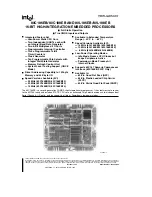
SM320F2812-HT
SGUS062B
–
JUNE 2009
–
REVISED JUNE 2011
www.ti.com
6.25 External Interface Ready-on-Read Timing With One External Wait State
Table 6-37. External Memory Interface Read Switching Characteristics (Ready-on-Read, 1 Wait State)
(1)
PARAMETER
MIN
MAX
UNIT
t
d(XCOH-XZCSL)
Delay time, XCLKOUT high to zone chip-select active low
1
ns
t
d(XCOHL-XZCSH)
Delay time, XCLKOUT high/low to zone chip-select inactive high
–
2
3
ns
t
d(XCOH-XA)
Delay time, XCLKOUT high to address valid
2
ns
t
d(XCOHL-XRDL)
Delay time, XCLKOUT high/low to XRD active low
1
ns
t
d(XCOHL-XRDH
Delay time, XCLKOUT high/low to XRD inactive high
–
2
1
ns
t
h(XA)XZCSH
Hold time, address valid after zone chip-select inactive high
(2)
ns
t
h(XA)XRD
Hold time, address valid after XRD inactive high
(2)
ns
(1)
Not production tested.
(2)
During inactive cycles, the XINTF address bus always holds the last address put out on the bus. This includes alignment cycles.
Table 6-38. External Memory Interface Read Timing Requirements (Ready-on-Read, 1 Wait State)
(1)
MIN
MAX
UNIT
t
a(A)
Access time, read data from address valid
(LR + AR)
–
14
(2)
ns
t
a(XRD)
Access time, read data valid from XRD active low
AR
–
12
(2)
ns
t
su(XD)XRD
Setup time, read data valid before XRD strobe inactive high
12
ns
t
h(XD)XRD
Hold time, read data valid after XRD inactive high
0
ns
(1)
Not production tested.
(2)
LR = Lead period, read access. AR = Active period, read access. See
Table 6-25
.
Table 6-39. Synchronous XREADY Timing Requirements (Ready-on-Read, 1 Wait State)
(1) (2)
MIN
MAX
UNIT
t
su(XRDYsynchL)XCOHL
Setup time, XREADY (Synch) low before XCLKOUT high/low
15
ns
t
h(XRDYsynchL)
Hold time, XREADY (Synch) low
12
ns
t
e(XRDYsynchH)
Earliest time XREADY (Synch) can go high before the sampling XCLKOUT edge
3
ns
t
su(XRDYsynchH)XCOHL
Setup time, XREADY (Synch) high before XCLKOUT high/low
15
ns
t
h(XRDYsynchH)XZCSH
Hold time, XREADY (Synch) held high after zone chip select high
0
ns
(1)
Not production tested.
(2)
The first XREADY (Synch) sample occurs with respect to E in
Figure 6-31
:
E = (X XRDACTIVE) t
c(XTIM)
When first sampled, if XREADY (Synch) is found to be high, then the access completes. If XREADY (Synch) is found to be low, it is
sampled again each t
c(XTIM)
until it is found to be high.
For each sample (n) the setup time (D) with respect to the beginning of the access can be calculated as:
D = (X XRD n
–
1) t
c(XTIM)
–
t
su(XRDYsynchL)XCOHL
where n is the sample number: n = 1, 2, 3, and so forth.
Table 6-40. Asynchronous XREADY Timing Requirements (Ready-on-Read, 1 Wait State)
(1) (2)
MIN
MAX
UNIT
t
su(XRDYAsynchL)XCOHL
Setup time, XREADY (Asynch) low before XCLKOUT high/low
11
ns
t
h(XRDYAsynchL)
Hold time, XREADY (Asynch) low
8
ns
Earliest time XREADY (Asynch) can go high before the sampling XCLKOUT
t
e(XRDYAsynchH)
3
ns
edge
t
su(XRDYAsynchH)XCOHL
Setup time, XREADY (Asynch) high before XCLKOUT high/low
11
ns
(1)
Not production tested.
(2)
The first XREADY (Asynch) sample occurs with respect to E in
Figure 6-32
:
E = (X XRDACTIVE
–
2) t
c(XTIM)
When first sampled, if XREADY (Asynch) is found to be high, then the access completes. If XREADY (Asynch) is found to be low, it wis
sampled again each t
c(XTIM)
until it is found to be high.
For each sample, setup time from the beginning of the access can be calculated as:
D = (X XRDACTIVE
–
3 + n) t
c(XTIM)
–
t
su(XRDYasynchL)XCOHL
where n is the sample number: n = 1, 2, 3, and so forth.
122
Electrical Specifications
Copyright
©
2009
–
2011, Texas Instruments Incorporated
Submit Documentation Feedback
Product Folder Link(s):
SM320F2812-HT
Summary of Contents for SM320F2812-HT Data
Page 152: ......
















































